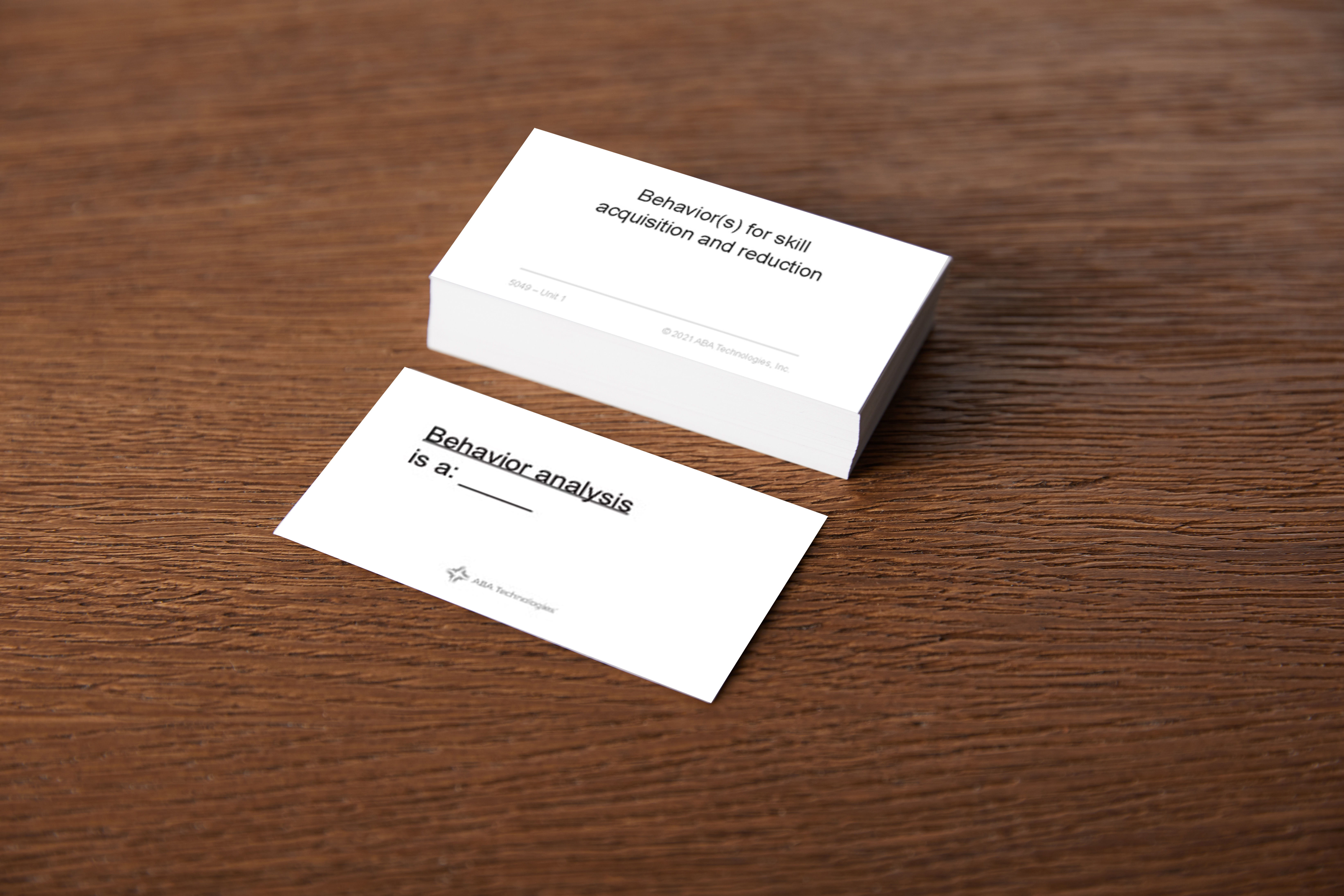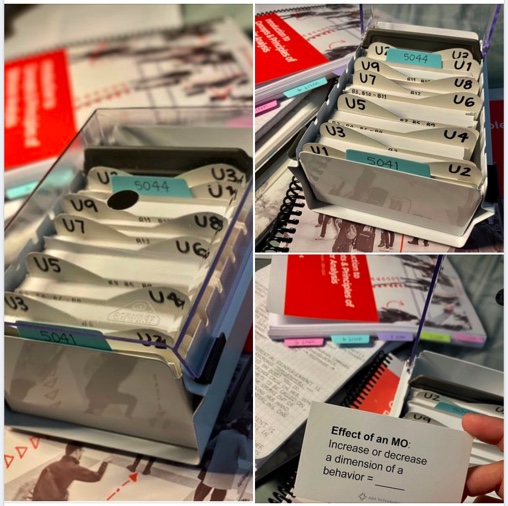
Why use SAFMEDS Fluency Flashcards?
Throughout your coursework, you’re going to learn a lot of behavior-analytic terminologies, concepts, and skills. To be effective in your practice as a behavior analyst, you’ll want to have mastery of those terminologies, concepts, and skills. No one wants to be slowly recalling the definition of positive reinforcement or the steps of behavioral skills training while simultaneously trying to apply them. This is the reason we practice flashcards in a special way; to develop not only your accuracy with the material but your speed as well. We call this combination of accuracy and speed fluency.
You’re likely very familiar with that concept—someone fluent in playing piano isn’t constantly looking at their fingers to find the next note on the keyboard. Similarly, someone fluent in a language isn’t stopping every five words to recall the next word in a sentence. The performance of a fluent skill is fast, effortless, and without hesitation. We want you to be fluent behavior analysts, fluent with the technical language, procedures, and application of all of that. SAFMEDS, also known as Fluency Flashcards, is how you’re going to get there.
What makes SAFMEDS different from regular flashcards?
SAFMEDS are a flashcard technology developed by Drs. Ogden Lindsley and Steve Graf in 1978, both of whom were behavior analysts and precision teachers. Thousands of students over many decades have been required to complete SAFMEDS as an essential component of their training. Since their creation, this learning technology has been used predominantly in undergraduate and graduate student settings, though it is also becoming known in populations of users in medical environments and business environments.
Unlike regular flashcards, Fluency Flashcards are created using performance goals that account for accuracy and fluency. They are also intended to be used during timed intervals of practice, whereas regular flashcards are generally practiced in an untimed manner.
Traditional flashcards also often lack instructional design. SAFMEDS include set principles for formatting and design to guide SAFMEDS developers. For example, how a card is written for a concept is different from a word association or a quote.
How do you use SAFMEDS?
- SAY: You will see the front side of the card and say the answer (on the back) aloud. You don’t need to say the side that you see, just the answer.
 ALL: You are going to practice all the cards in the deck every time you practice, except if you need to troubleshoot or apply an intervention.
ALL: You are going to practice all the cards in the deck every time you practice, except if you need to troubleshoot or apply an intervention.- FAST: You’re going to practice them quickly, getting faster and faster. This is different from traditional flashcards.
- MINUTE: You’ll practice these for a timed interval, and we recommend one minute.
- EVERY DAY: You’re going to practice SAFMEDS each and every day—not once a week, not 20 minutes before the Fluency Quick Quiz—no, SAFMEDS are meant to be practiced every day until they are mastered, and it takes fewer than 10 minutes, and eventually 2 minutes, to do every day.
- SHUFFLED: Instead of practicing the cards in the same order, you’re going to practice them in a random order. With paper cards, you would mix them up between your timings; with digital flashcard apps, you would turn on a shuffle function. This will ensure you are truly learning your SAFMEDS and not memorizing them based on order.
How do SAFMEDS apply to coursework in the ABA Online Program?
ABA Technologies produces SAFMEDS for each unit in the ABA Online Program. Those sets combine into a deck for the entire course. When each unit opens, it’s recommended that students start practicing the cards using the SAFMEDS approach. Every day, complete several timings until errors decrease, corrects increase, and there’s no stumbling or hesitation when saying answers. After each timing, students are encouraged to record their score and try to get a better score on the next timing, then repeat this over several days leading up to the Fluency Quick Quiz that happens at the end of the unit. Throughout, students are encouraged to go back and diagnose common errors and study certain cards in isolation.
Why should I purchase SAFMEDS from ABA Technologies?
We’ve heard from countless students about the positive impact SAFMEDS have had on their preparation for other courses, performance on the BACB® exam, and confidence in clinical practice. Students will have access to a digital version of these flashcards, but many prefer the experience of learning the cards with a tangible set of paper cards they can hold in their hands.
 Rather than spending precious time formatting, printing, and cutting up hundreds of SAFMEDS cards per course at home, or spending time writing the front and back of thousands of notecards throughout the ABA Online Program where ink can bleed through, and it can be difficult to flip cards quickly, we have produced high-quality printed versions of Fluency Flashcards for each course, which are labeled with each unit they correspond to for the student’s convenience. They’re printed on sturdy cardstock paper that is easy to flip through quickly, like a deck of playing cards, and the answers are not visible through the opposite side of each card.
Rather than spending precious time formatting, printing, and cutting up hundreds of SAFMEDS cards per course at home, or spending time writing the front and back of thousands of notecards throughout the ABA Online Program where ink can bleed through, and it can be difficult to flip cards quickly, we have produced high-quality printed versions of Fluency Flashcards for each course, which are labeled with each unit they correspond to for the student’s convenience. They’re printed on sturdy cardstock paper that is easy to flip through quickly, like a deck of playing cards, and the answers are not visible through the opposite side of each card.
These have been developed specifically with students of the ABA Online Master’s Program in mind by the same instructors and curriculum developers who produced the coursework. They are priced very near the cost of production to keep them as accessible as possible, as we believe this is a critical learning tool for students of behavior analysis.
Tips for being successful with this fluency component of your coursework:
- Start early. Rome wasn’t built in a day, and neither was your knowledge of behavior analysis. Make future-you happy by not waiting until the last minute—you have to put the work in to become a competent behavior analyst!
- Shuffle! Turn the shuffle function on in the digital flashcard app, or when using paper cards, be sure to shuffle the cards from the unit you’re studying. Once you’re fluent with the current unit, you can also shuffle in the cards from previous units in the course to test your
 fluency in concepts throughout and see that you’re retaining Fluency Flashcards you learned previously. Always shuffle!
fluency in concepts throughout and see that you’re retaining Fluency Flashcards you learned previously. Always shuffle! - Get organized. If looking at the huge stack of SAFMEDS you’ll learn throughout the course feels daunting or overwhelming, it can help to visually break them into their units, so you know you’re working in smaller, manageable chunks.
- Timed practice. Spend more time doing timed practice than doing untimed practice. Some students think that if they go slowly for many days, just get all those cards correct, it will help with the speed, but that is generally not the case. If you are someone who doesn’t have a history of having their performance timed or experience negative private events when they do (e.g., increased heart rate or negative thoughts), doing daily timed practice will make you better at being timed. People can learn to perform better under timed conditions if they practice under timed conditions. To that point, most of the tests in this program and for Board Certification are going to be timed—this is good practice!
- Prepare for the Fluency Quick Quiz. At the end of each unit in the ABA Online Program; you will be required to complete a timed unit Fluency Quick Quiz. These are for your benefit; an accountability check for doing something that might not be fun to do every day but will be beneficial for you in the long run. Yes, these can be challenging, and if you aren’t happy with your score or find them stressful, we’re going to give you the same advice: go back to the SAFMEDS cards and practice them several times per day, shuffled, for one-minute timings, with the focus on increasing corrects and decreasing errors. You will learn to get better at Fluency Quick Quizzes, too. People who master the SAFMEDS with fluency can tackle the timed Fluency Quick Quiz.
- Breathe. Practice. Pause. Reset. Try again. Breathe before you start each timing. Get your body completely relaxed. SAFMEDS are a low-stakes assignment, yet many people feel completely stressed out when they have to try them. You can learn to master the cards with speed while in a relaxed position, and that can start with a simple breath. If you get tight and stressed out, stop the timing, take a breath, find a neutral voice, and begin again.
- Always record your score. Write it down as soon as you finish your timing and do a little troubleshooting by going back to problematic cards and reviewing them several times before beginning the next timing.
Give yourself a pat on the back for every step toward your fluency goal with SAFMEDS!


